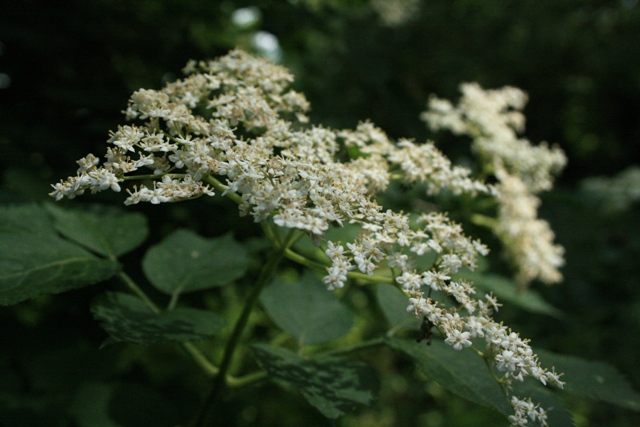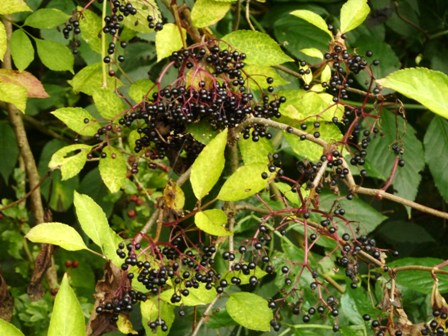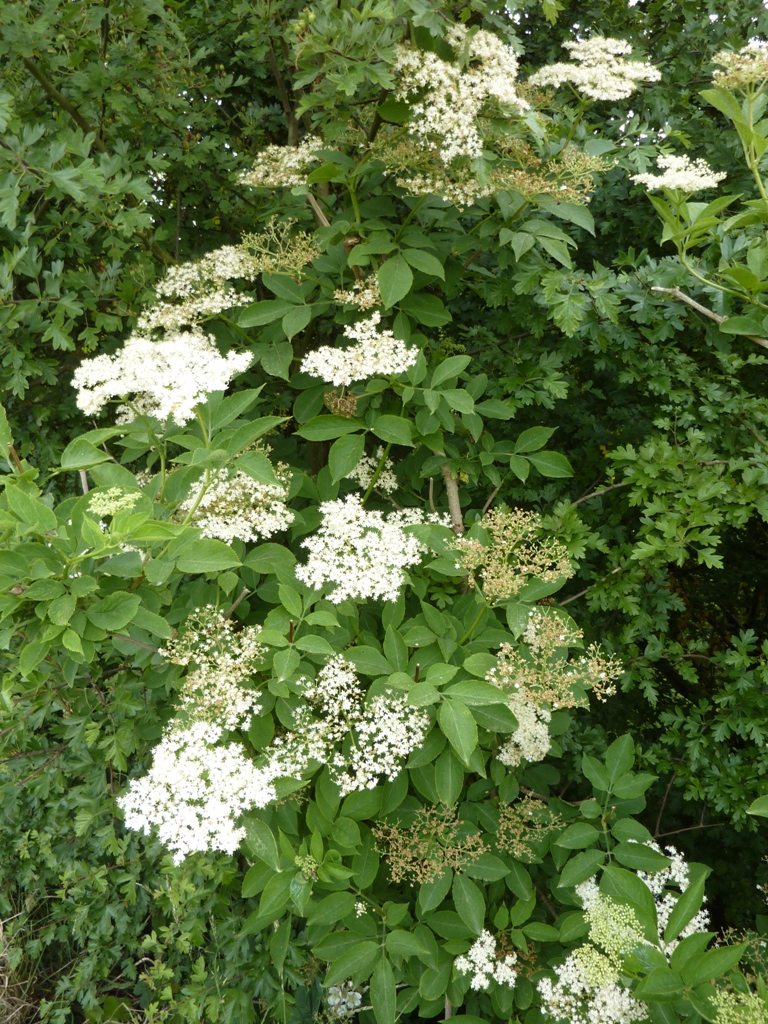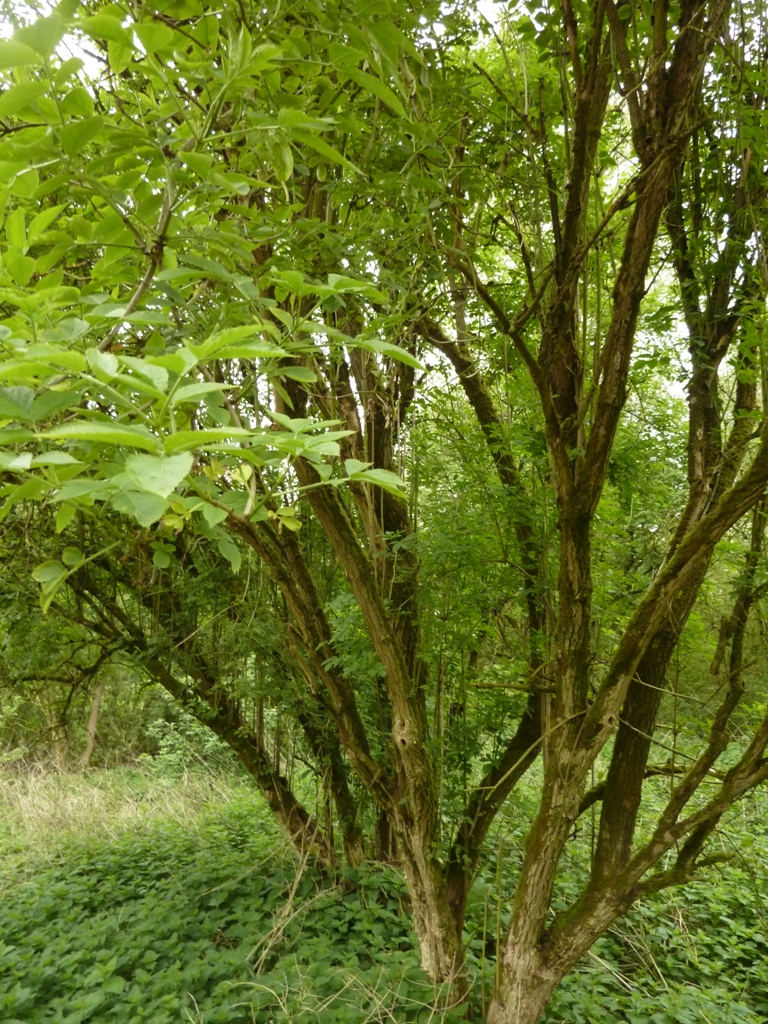In Part 1 our main Common Elder or Sambucus nigra was described for all its many virtues. It has moved just as the members in this post from the former Caprifoliaceae to the Adoxacea in the last edition of Stace.
The Adoxaceae is a small family consisting of five genera and about 150–200 species.
In older classifications, this entire family was part of Caprifoliaceae or the honeysuckle family. Adoxa (moschatel) was the first plant to be moved to this new group. Much later, the genera Sambucus (Elders) and Viburnum were added after careful morphological analysis and biochemical tests by the Angiosperm Phylogeny Group.
Contents:
Adoxa moschatellina or Moschatel
Viburnum
V. opulus or Guelder rose
V. lantana or Wayfayring tree
Sambucus ebulus or Dwarf Elder (Archaeophyte)
Sambucus canadensis or American Elder (Neophyte)
Sambucus racemosa or Red-berried Elder (Neophyte)
For easier reading I’ve used colour coding! Blue background for interesting facts and wildlife uses, green for edible and other uses, red for danger or medicinal uses.
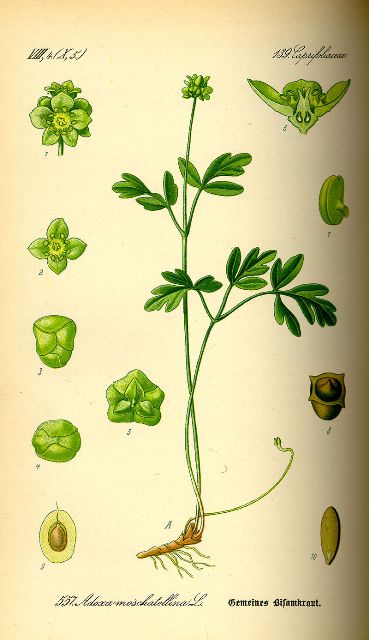
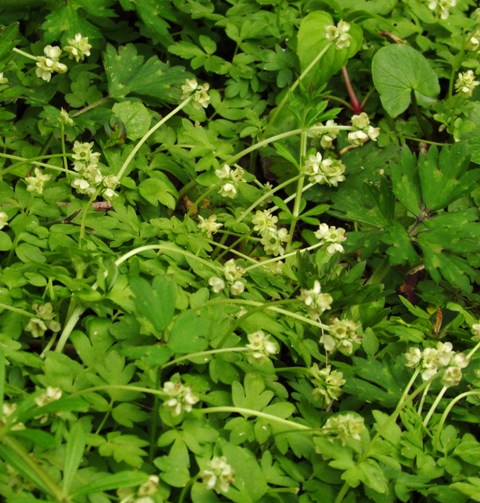
Picture on right by Matt Summers
Adoxa moschatellina or Moschatel
A perennial rhizomatous herb of mesic brown earth soils on the shaded banks of rivers and streams, in deciduous woodlands and shaded hedgebanks; also occasionally in shaded base-rich sites in mountains. This is a vernal species which disappears by May or June immediately after the berries are mature.
Moschatel has six other interesting common names: five-faced bishop, hollowroot, muskroot, townhall clock, tuberous crowfoot and Good Friday plant!
Distribution:
It has a boreal, circumpolar distribution in Europe, Asia and North America. It is widespread and common in most parts of the British Isles, preferring damp shady situations, but becomes scarce in the north and west of Scotland and parts of eastern England.
It is absent from Ireland. Its distribution in parts of Wales is localised, occurring only at sites where are base rich soil, such as Coed Dolgarrog National Nature Reserve in Conwy.
No known uses to people, just an interesting little plant! The plant and its flowers have a musk-like scent, which it emits towards evening when the dew falls. If the plant is bruised this scent disappears.
Viburnum
Viburnum is a genus of about 150–175 species of evergreen or deciduous shrubs or (in a few cases) small trees native throughout the temperate Northern Hemisphere.
It has only two known native species and about 6 species occasionally occurring in the wild which are escaped from gardens and naturalized.
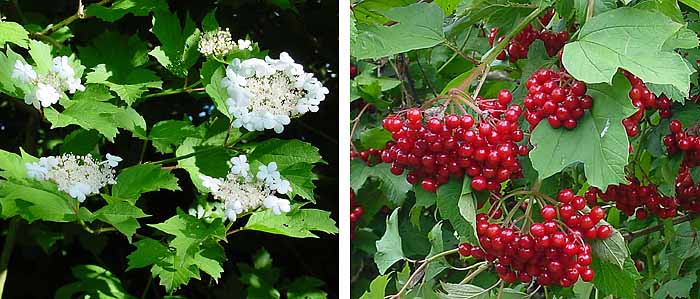
Viburnum opulus or Guelder rose.
A deciduous shrub of neutral or calcareous soils favouring damp, winter-wet areas within and on the edge of woodland, scrub, plantations and hedgerows (especially well-established ones), in fen-carr, alder and willow thickets, marsh edges and on stream banks. It is also occasionally found in drier habitats such as tracksides, road verges, waste ground and in rough grassland. It is now widely planted, and bird-sown plants which spread from planted sites to the wild sometimes include yellow-fruited cultivars.
The common name ‘guelder rose’ relates to the Dutch province of Gelderland, where a popular cultivar, the snowball tree, supposedly originated.
It is a rare shrub and is an ancient-woodland indicator. If you spot it while you’re out exploring, it could be a sign you’re standing in a rare and special habitat.
The red berries are an important food source for birds, including bullfinch and mistle thrush. The shrub canopy provides shelter for other wildlife. The flowers are especially attractive to hoverflies.
It is a useful and beautiful hedgerow plant also grown as an ornamental plant for its flowers, autumn colour and berries, growing best on moist, moderately alkaline soils, though tolerating most soil types well.
Several cultivars have been selected, including ‘Roseum’ (synonym ‘Sterile’, ‘Snowball’), in which all the flowers are only of the larger sterile type, with globular flower heads.
The fruit is edible in small quantities, with a very acidic taste; it can be used to make jelly.
It is however mildly toxic, and may cause vomiting or diarrhea if eaten in large amounts.
Guelder Rose is able to relieve muscle tension, both in skeletal muscles and in the smooth muscle of the intestines, lungs and uterus. It is used on its own for cramps and muscle spasms, including uterine cramps, back pain, fibromyalgia and irritable bowel syndrome. Also in formulae for high blood pressure, arthritis and nervous tension.
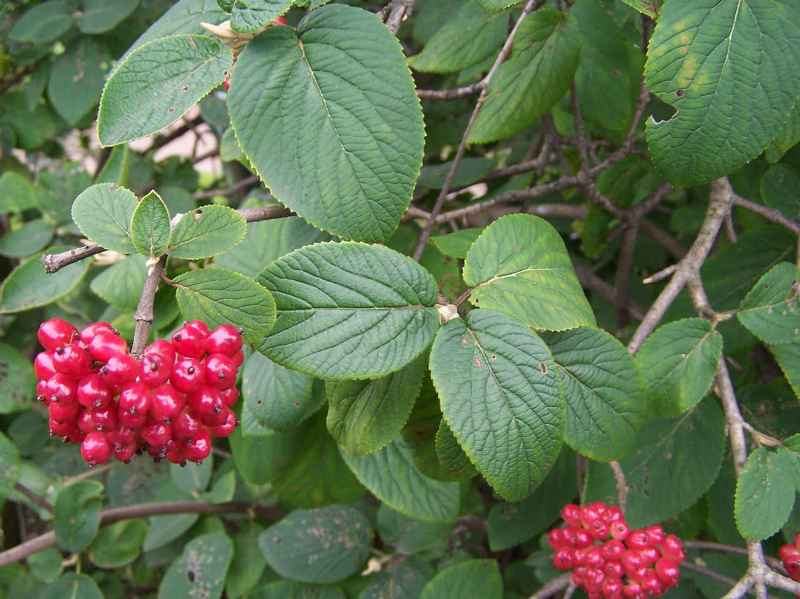
Viburnum lantana or Wayfayring tree
A deciduous shrub of woods and wood borders, scrub, hedgerows and rough grassland on base-rich soils, especially in chalk and limestone districts. It is now frequently planted on road- and canal-sides, in parks, shrubberies, habitat creation schemes (often in areas where the species is native) and may also appear when used as a stock for other cultivated species of Viburnum. Bird-sown populations also occur on waste ground and in other ruderal situations and its unpalatability to rabbits allows it to invade areas of high warren densities.
Birds will eat the berries and insects such as hoverflies feed on the nectar. The larvae of several moth species will feed on the leaves.
These days, cultivated varieties of the wayfaring tree are often planted as an ornamental.
Traditionally, however, it was used for other purposes. Its strong bendy stalks used to be used to tie hay bales, and there is evidence that, in Europe at least, its straight wood was used to make arrows.
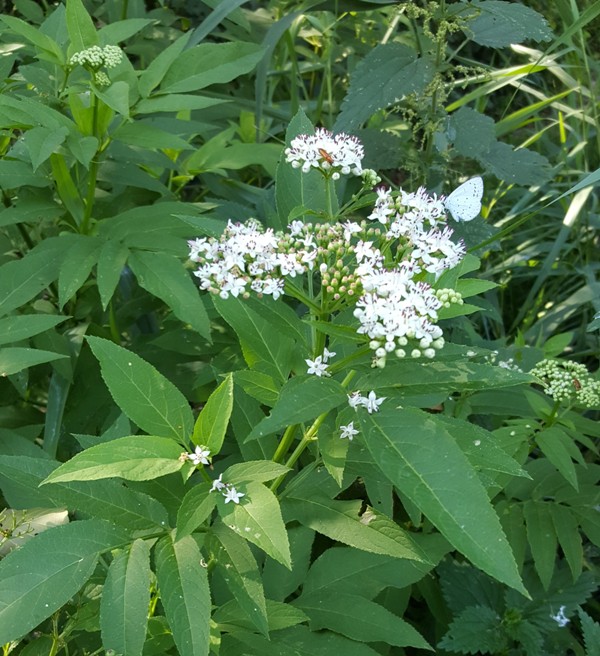
Sambucus ebulus or Dwarf Elder (Archaeophyte)
A robust herbaceous perennial, spreading vigorously by rhizomes, and formerly widely planted for medicinal use and the production of a blue dye. It occurs infrequently in hedgerows, on roadsides and waste ground, usually in small numbers but locally forming thickets (Lavin & Wilmore, 1994) where it can be very persistent.
This is a less known herbaceous species of Elder also known as danewort, dane weed, danesblood, European dwarf elder, walewort, dwarf elderberry, elderwort and blood hilder. It is native to southern and central Europe and southwest Asia. It is an archaeophyte in the B.I. according to Stace
The name danewort comes from the belief that it only grows on the sites of battles that involved the Danes. The term ‘walewort’ or ‘walwort’ meant ‘foreigner plant.’ The plant’s stems and leaves turn red in autumn and this may explain the link with blood. The word Dane may link to an old term for diarrhoea.
Fruit – cooked. It is used as a flavouring in soups. Leaves are used as a tea substitute.
The fruit of this species has been known to cause stomach upsets to some people. Any toxin the fruit might contain is liable to be of very low toxicity and is destroyed when the fruit is cooked.
Medicinal Uses:
Dwarf elder is one of the best known medicinal herbs since ancient times. In view of its benefits as a widely applicable phytomedicine, it is still used in folk medicine of different parts of the world. In addition to its nutritional values, dwarf elder contains different phytochemicals among which flavonoids and lectins are responsible for most of its therapeutic effects. Dwarf elder has been used for different ailments including: joint pains, cold, wounds, and infections.
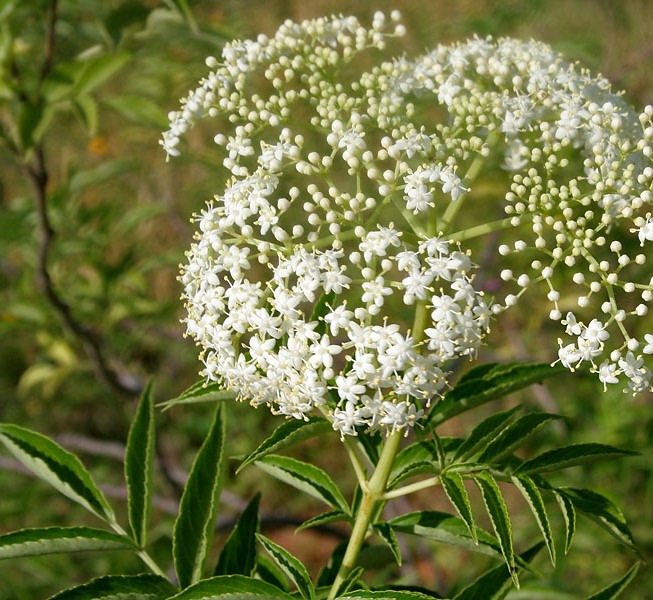
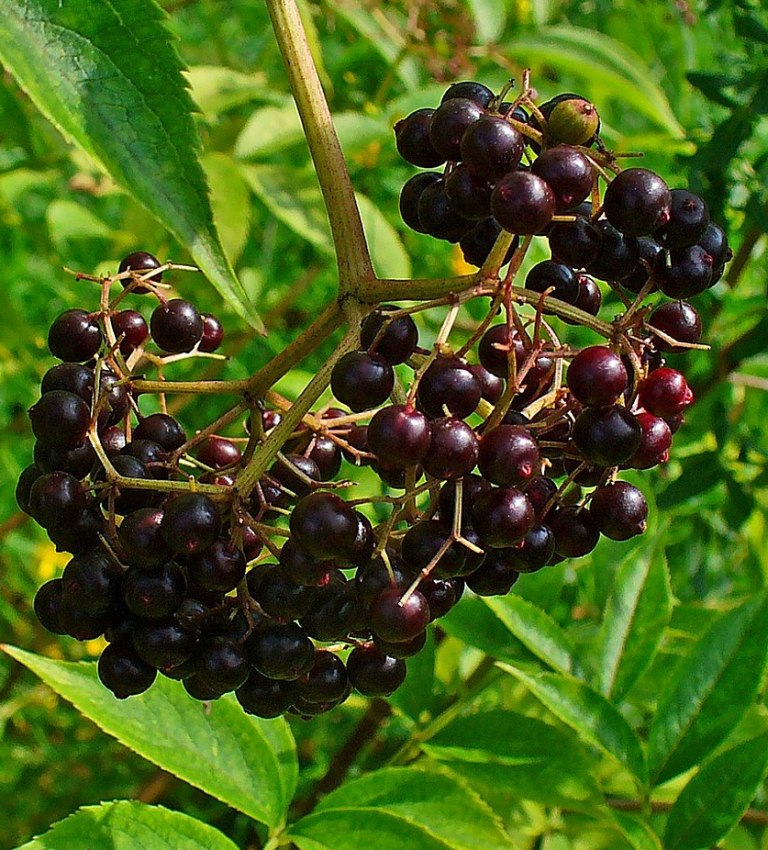
Flower and fruit of Sambucus canadensis or American Elder
Sambucus canadensis or American Elder (Neophyte)
A deciduous shrub that is planted and naturalized along railway banks, hedges and roadsides, and also occurs in scrub and on waste ground. It reproduces by seed, which may be bird-sown, and vegetatively by suckering.
Similarly as the Common Elder, the flower is edible, as are the ripe berries. A drink can be made from soaking the flower heads in water for eight hours. Other uses for the fruit include wine, jelly and dye. The leaves and inner bark can be used as an insecticide and a dye. The leaves are also traditionally used topically in herbalism.
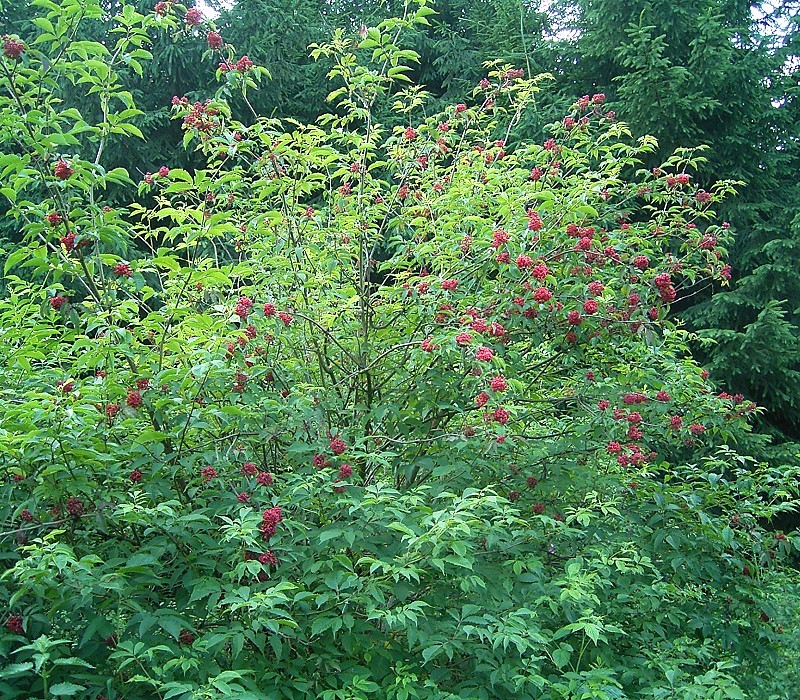
Sambucus racemosa or Red-berried Elder (Neophyte)
A deciduous shrub established in woodland, shrubberies, hedges and waste ground, and planted as game cover in parts of northern England and Scotland.
The fruits are reportedly safe to eat when cooked, but are potentially poisonous when raw. For more uses follow the link above.

